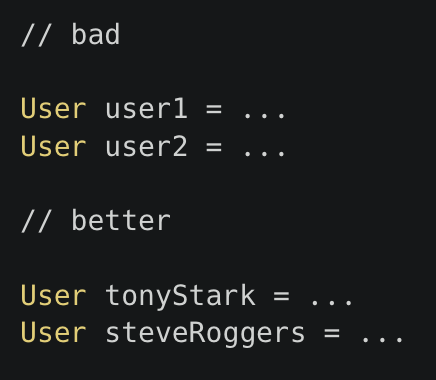· 2 min read
Writing cleaner tests with creative variable names
Creative variable names in tests can make them fun and interesting to read.

Variable and method names provide a context that makes it easy to understand a piece of code.
Typically in code, it’s enough to have the same variable name as the class name.
So for example, if you have a User class, the object name could be user.
User user = new User(request.getFirstName(), request.getLastName());This looks good in code but gets messy in tests especially when there are multiple instances of the same object.
User user1 = new User("user 1 first name", "user 1 last name", ...10 other fields...);
.
.
.
User user2 = new User("user 2 first name", "user 1 last name", ...10 other fields...);
.
.
.
// someAssertionThatUses user1 And user2A better approach is to use a TestData class which I have described in a separate blogpost
User user1 = UserTestData.Given.aUser("user 1 first name", "user 1 last name");
.
.
.
User user2 = UserTestData.Given.aUser("user 2 first name", "user 1 last name");
.
.
.
// someAssertionThatUses user1 And user2In the above statement, having the factory UserTestData.Given.aUser encapsulates creation making the test a bit cleaner.
But still, at the end of the test in the assertions section, the coder will have to remember what the data in user1 and user2
A better way is to have creative variable names here.
User tonyStark = UserTestData.Given.aUser("Tony", "Stark");
.
.
.
User steveRoggers = UserTestData.Given.aUser("Steve", "Roggers");
.
.
.
// someAssertionThatUses tonyStark And steveRogersNow within assertion, the developer will know the exact data in both the User objects.
This not only makes tests cleaner but also makes them funny and exciting to read.